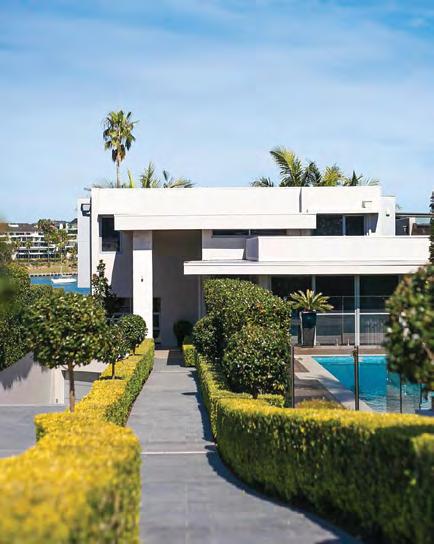
6 minute read
GOLD MINES TO SAFE HOUSES
04 GOLD MINES TO SAFE HOUSES
OVER THREE DECADES OF UNPRECEDENTED CONTINUOUS ECONOMIC GROWTH, RESIDENTIAL REAL ESTATE HAS TYPICALLY BEEN A GOLD MINE FOR ORDINARY AUSTRALIAN HOMEOWNERS AND INVESTORS
The simple, age-old method of buying and holding long term has netted extraordinary wealth for many people.
But in 2020, our economy weakened and our homes and investments took on new meaning, converting temporarily from gold mines to safe houses, providing flexibility to help owners navigate a tough economy ahead.
Since the onset of the virus, some owners such as Generation X have been refinancing to withdraw equity, taking advantage of the lowest interest rates in history to renovate their homes and upgrade their lifestyles. The first national lockdown inspired a surge in home improvements.
Research shows some 9% of owners are considering downsizing to a smaller home1 on less debt. Younger owners might consider ‘rentvesting’, where they move out of their first home and lease it to create rental income and reduce outgoings, whilst moving somewhere cheaper themselves. Others, such as Baby Boomers, are selling up in metropolitan areas and relocating to lifestyle locations, enjoying the same style of home with residual cash to save.
Some have realised the opportunity that low interest rates present and have sold well during the virus to upsize their homes.
The magnificent resilience of our national market has meant prices have softened only slightly, despite the impact of a once-in-a-century pandemic and the recession it has caused.
This has enabled homeowners and investors to sell, if they like, often without too much compromise on price and sometimes for well above reserve at auction, depending on the type and location of the home.
PHOTOGRAPHY: SUPPLIED BY MCGRATH ESTATE AGENTS
90% RISE IN HOME PRICES JAN 2005 - MAR 2020 65% RISE IN AVERAGE EARNINGS NOV 2004 - NOV 2019
Young first home buyers have retained their enthusiasm for property and are still buying in droves, possibly with a new appreciation for the security of bricks and mortar as an essential cornerstone asset.
Owning property remains the Great Australian Dream. Two out of three residences are owned or mortgaged2 and 2.2 million Australians own one or more investment properties3 .
Over the past decade, we have made more from our properties than our jobs, with house price growth outstripping wages growth. Data from the Australian Bureau of Statistics (ABS) and CoreLogic shows home prices rose by 90% between January 2005 and March 2020 whilst average weekly earnings rose 65% between November 2004 and November 20194 .
The virus-induced change in our economic climate has many people worried. One in four are concerned about their ability to pay bills, 84% are worried about the local economy, 85% are fretting about the global economy; and 29% are concerned about job security5 .
Looking ahead, when stimulus is pulled back and mortgage deferrals end, what will happen next?
PHOTOGRAPHY: SUPPLIED BY McGRATH ESTATE AGENTS

Our homes are our castles and Australians will instinctively want to hold on to their assets. In the first few months of recession, our main counteractive move was to rein in spending and pay off debt. We also found different ways to use our cornerstone asset to support any change in circumstances or lifestyle.
Figures from the ABS6 show external refinancing (refinancing with another lender) surged from $5.7 billion worth of new refinanced loans in May 2019 to $10 billion in May 2020 – the highest value ever logged since records began in July 2002. Before the pandemic, it was $6.3 billion in February 2020.
In a strategy dubbed ‘Houses as ATMs’, U.S. research shows refinancing tends to spike before recessions as people become concerned about their incomes and jobs7 .
However, these borrowers aren’t always just seeking lower rates. That opportunity is merely a by-product of today’s policy settings. Instead, borrowers typically refinance by replacing their mortgage with a larger loan to access equity. They get liquid to ride out the downturn.
The ABS calls this ‘internal refinancing’ and it steadily rose over the first few months of the pandemic from $4.3 billion in February 2020 to $5.3 billion in May 20206 .
Some borrowers might use this equity to cover loan repayments whilst their incomes are compromised. Others might renovate or buy more property whilst prices are softer.
Some 9% of Australians were already considering buying an investment before the virus. By August 2020, 14% were thinking about doing so within the next 12 months1 .
Young Australians are bearing the brunt of the recession, so far. In April 2020 alone, 213,000 people aged 15-24 years lost their jobs as unemployment for that age group rose from 11.5% to 13.8%8. Youth unemployment stood at 14.3% by August 20209 .
This is likely to exacerbate the rapidly growing cultural trend of young adults turning to their parents for help with a home, either by living with them longer; moving back to the family nest after renting; or tapping into the Bank of Mum and Dad to help them buy.
Rising affordability challenges and the influences of multiculturalism have created this trend and the pandemic has propelled it. By May 2020, 331,339 young Australians had joined ‘Generation Boomerang’ and moved back home with their parents because of the pandemic10 .
First home buyer activity across Australia was at a 10-year high at the end of 2019 and this trend continued in early 2020, encouraged by the Federal Government’s First Home Loan Deposit Scheme, stamp duty concessions and First Home Owner Grants.
Scan here for more insights. 213,000 PEOPLE AGED 15-24 YEARS LOST THEIR JOBS IN APRIL 2020 ALONE
The Bank of Mum and Dad is now the nation’s fifth biggest home lender11. Australian parents have been lending an average of $73,522 to help their kids get a foothold on the property ladder. That totals a huge $92 billion and represents growth of 41% since 201711 .
Now that we are in recession, parents are concerned about the impact on their super and others are grappling with reduced dividends and virtually no interest on deposits. Young people might have to find another way to fund their home ownership dreams for a while.
The last resort for property owners will be to sell their properties – either their primary residence or an investment property, which could increase supply in the market for a period.
Despite the perennial doomsday predictions, history paints a glowing picture of property price resilience in Australia. Based on this, house price falls are unlikely to be sustained for a prolonged period. House prices have rebounded after every recession or downturn in the past 50 years, including the early 1990s recession and the Global Financial Crisis12 .
The importance and safety of bricks and mortar is set to become further entrenched into the Australian psyche. As we navigate the worst economic downturn since the 1930s, property owners will discover the true value of their assets when times get tough.










